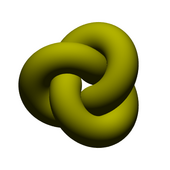Ropelength
In physical knot theory, each realization of a link or knot has an associated ropelength. Intuitively this is the minimal length of an ideally flexible rope that is needed to tie a given link, or knot. Knots and links that minimize ropelength are called ideal knots and ideal links respectively.

Definition
[edit]The ropelength of a knotted curve is defined as the ratio , where is the length of and is the knot thickness of .
Ropelength can be turned into a knot invariant by defining the ropelength of a knot to be the minimum ropelength over all curves that realize .
Ropelength minimizers
[edit]One of the earliest knot theory questions was posed in the following terms:
In terms of ropelength, this asks if there is a knot with ropelength . The answer is no: an argument using quadrisecants shows that the ropelength of any nontrivial knot has to be at least .[1] However, the search for the answer has spurred research on both theoretical and computational ground. It has been shown that for each link type there is a ropelength minimizer although it may only be of differentiability class .[2][3] For the simplest nontrivial knot, the trefoil knot, computer simulations have shown that its minimum ropelength is at most 16.372.[1]
Dependence on crossing number
[edit]An extensive search has been devoted to showing relations between ropelength and other knot invariants such as the crossing number of a knot. For every knot , the ropelength of is at least proportional to , where denotes the crossing number.[4] There exist knots and links, namely the torus knots and -Hopf links, for which this lower bound is tight. That is, for these knots (in big O notation),[3]
On the other hand, there also exist knots whose ropelength is larger, proportional to the crossing number itself rather than to a smaller power of it.[5] This is nearly tight, as for every knot, The proof of this near-linear upper bound uses a divide-and-conquer argument to show that minimum projections of knots can be embedded as planar graphs in the cubic lattice.[6] However, no one has yet observed a knot family with super-linear dependence of length on crossing number and it is conjectured that the tight upper bound should be linear.[7]
References
[edit]- ^ a b Denne, Elizabeth; Diao, Yuanan; Sullivan, John M. (2006), "Quadrisecants give new lower bounds for the ropelength of a knot", Geometry & Topology, 10: 1–26, arXiv:math/0408026, doi:10.2140/gt.2006.10.1, MR 2207788
- ^ Gonzalez, O.; Maddocks, J. H.; Schuricht, F.; von der Mosel, H. (2002), "Global curvature and self-contact of nonlinearly elastic curves and rods", Calculus of Variations and Partial Differential Equations, 14 (1): 29–68, doi:10.1007/s005260100089, MR 1883599
- ^ a b Cantarella, Jason; Kusner, Robert B.; Sullivan, John M. (2002), "On the minimum ropelength of knots and links" (PDF), Inventiones Mathematicae, 150 (2): 257–286, arXiv:math/0103224, Bibcode:2002InMat.150..257C, doi:10.1007/s00222-002-0234-y, MR 1933586
- ^ Buck, Gregory; Simon, Jonathan (1999), "Thickness and crossing number of knots", Topology and its Applications, 91 (3): 245–257, doi:10.1016/S0166-8641(97)00211-3, MR 1666650
- ^ Diao, Y.; Ernst, C.; Thistlethwaite, M. (2003), "The linear growth in the lengths of a family of thick knots", Journal of Knot Theory and its Ramifications, 12 (5): 709–715, doi:10.1142/S0218216503002615, MR 1999639
- ^ Diao, Yuanan; Ernst, Claus; Por, Attila; Ziegler, Uta (2019), "The Ropelengths of Knots Are Almost Linear in Terms of Their Crossing Numbers", Journal of Knot Theory and its Ramifications, 28 (14): 1950085, doi:10.1142/S0218216519500858
- ^ Diao, Yuanan; Ernst, Claus (2004), "Realizable powers of ropelengths by non-trivial knot families" (PDF), JP Journal of Geometry and Topology, 4 (2): 197–208, MR 2105812, archived from the original (PDF) on 2005-02-15














